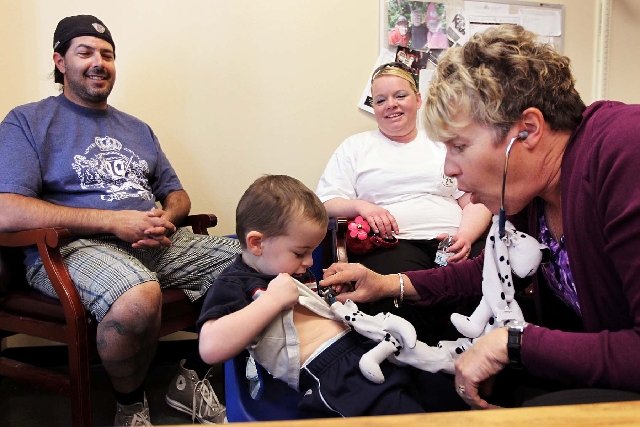Clark County School District and its nurses prepare for disasters

Earthquake . Widespread contagion. Terrorist attack.
“You know something’s coming. You just don’t know when,” said Linda Kalekas, a health services coordinator for the Clark County School District.
Although not a first responder, the district would likely be called upon in a large-scale disaster. On top of having 357 schools spread throughout the county that could be used for triage, the nation’s fifth-largest school district also has 185 registered nurses.
It also has a 300,000-square-foot cold storage unit, the capability to prepare 150,000 meals a day and 1,500 buses.
“A mountain of untapped resources,” said Diana Taylor, the district’s health services director.
But, as school nurses have told Taylor and Kalekas, they’re not ready.
“This is something they’ve feared for a long time,” Kalekas said.
To care for disaster victims, nurses need more training and equipment in addition to the basic first-aid kits they have now. And the district is in desperate need of a way to communicate among its schools, local police and fire departments in the likely event that phones are down, said Paul Gerner, the district’s manager of emergency operations.
To make that happen, the district is preparing to pilot a plan years in the making, creating School Nurse Strike Teams and implementing a radio system to connect the district with local agencies. The seed money is $138,000 in federal grants from the U.S. departments of Homeland Security and Health and Human Services.
Gerner said the district has earnestly been working on a coordinated response to school-based emergencies — like a school shooting — or widespread disasters since the terrorist attacks of Sept. 11, 2001.
But officials quickly discovered the district’s shortcomings because of a report detailing its incapability to communicate not only with other local agencies but among its own schools.
This realization really hit home in a 2009 earthquake drill when officials had no way of reaching schools to find their conditions, Gerner said. Phone lines and cell towers would likely be down. Schools just have basic radios. Even sending police cars to schools would be out of the question as roads would be a mess.
“We realized we have a problem,” said Dimitri Theodorou, of the district’s emergency management department. “We need a solution. Here it is.”
Theodorou’s answer is a $6,000 handheld radio that enables internal communication among valley schools. It could also connect with local police and fire department radio systems.
“We’re not going to be jumping on Metro Police’s waves and messing things up,” but would be given a designated frequency, Gerner emphasized.
The district has 20 of these costly radios, but the goal is to have two in each school with four people trained to operate them, Theodorou said. School staff would then practice by using the radios in monthly fire, evacuation and lock-down drills.
A $49,500 Homeland Security grant would be used as a kickstart for the plan, funding the hire of a consultant to spend three months training a small group on how to use the radios in communicating with local police and fire departments. However, if the district can demonstrate the value of such an interconnected, valley wide system of schools and first responders, Gerner is convinced it will “create a magnet for further funding.”
Then there’s the $88,780 from the U.S. Department of Health and Human Services for School Nurse Strike Teams. Advanced training in trauma care will be provided to 40 nurses, covering everything from applying pressure bandages for arterial bleeding to treating spinal injuries and quickly identifying the severity of people’s conditions.
“Triage on steroids,” Taylor said.
Kalekas painted the picture of a pandemic spreading across the valley — like the movie “Contagion” — and school nurses setting up 18 centers at area schools to dispense medicine and provide care. Area hospitals and the Southern Nevada Health District wouldn’t be able to handle the demand alone. The school-based centers could each treat 5,000 to 10,000 people per day and move those in most need to hospitals.
“At the heart of everything I do is planning for the unexpected,” said Kalekas, whose background is in critical care. She has been developing the plan for School Nurse Strike Team for three years.
Theodorou said the district has been working in conjunction with local agencies to develop its emergency response plans.
“This is all a prototype,” he noted. “But if it takes off, it will go across the state and maybe go national.”
Contact reporter Trevon Milliard at tmilliard@reviewjournal.com or 702-383-0279.












